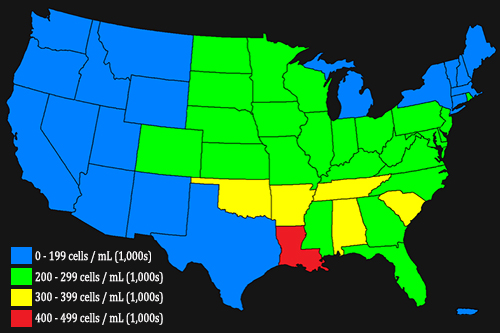After trending downward for nearly a decade, the somatic cell count average of herds enrolled in Dairy HerdInformation (DHI) testing rose this past year. Yet, it was a minor blip on the radar screen; SCC levels were up 1,000 cells/mL, reverting back to 2012's 200,000 cells/mL. Prior to this, average DHI test day SCC had declined each year since 2005. Regardless of this about face, SCC has experienced a 62 percent reduction since it peaked in 2001 at 322,000 cells/mL.
Compared to last year, 20 states gained SCC ground, noted a Council on Dairy Cattle Breeding research report. Meanwhile, 26 slid backwards, posting higher average totals than in the previous year. State average SCC generally was lower than the national average for mountain and western states and often higher for a few southeastern states. The top five dairy states averaged 193,000 cells/mL.
Click here to see the full table of characteristics of test-day milk yield and somatic cell count (SCC) from Dairy Herd Improvement herds during 2014 by herd size
The percentage of herd test days exceeding 750,000 and 400,000 cells/mL was 1.6 and 11.6 percent, respectively. As herd sizes have grown, milk yield and SCC generally improve
Average test-day somatic cell count from Dairy Herd Information herds during 2014 by state

If the SCC limit is lowered to 400,000 cells/mL, 16.9 percent of monthly tests would be above the limit for herds with fewer than 50 cows, 10.9 percent for herds with 50 to 99 cows, and 8.4 percent for herds with 100 to 149 cows. In contrast, 1.1 percent of the monthly tests were above this proposed cutoff for herds with over 3,000 cows.
To read the full Council on Dairy Cattle Breeding report, click the link.
Higher quality milk also goes hand in hand with cooler weather. SCC rose from April through July and then declined quickly from August through November. The highest quality milk was produced in January and November.

The author, Amanda Smith, was an an associate editor and is an animal science graduate of Cornell University. Smith covers feeding, milk quality and heads up the World Dairy Expo Supplement. She grew up on a Medina, N.Y., dairy, and interned at a 1,700-cow western New York dairy, a large New York calf and heifer farm, and studied in New Zealand for one semester.
Compared to last year, 20 states gained SCC ground, noted a Council on Dairy Cattle Breeding research report. Meanwhile, 26 slid backwards, posting higher average totals than in the previous year. State average SCC generally was lower than the national average for mountain and western states and often higher for a few southeastern states. The top five dairy states averaged 193,000 cells/mL.
Click here to see the full table of characteristics of test-day milk yield and somatic cell count (SCC) from Dairy Herd Improvement herds during 2014 by herd size
The percentage of herd test days exceeding 750,000 and 400,000 cells/mL was 1.6 and 11.6 percent, respectively. As herd sizes have grown, milk yield and SCC generally improve

If the SCC limit is lowered to 400,000 cells/mL, 16.9 percent of monthly tests would be above the limit for herds with fewer than 50 cows, 10.9 percent for herds with 50 to 99 cows, and 8.4 percent for herds with 100 to 149 cows. In contrast, 1.1 percent of the monthly tests were above this proposed cutoff for herds with over 3,000 cows.
To read the full Council on Dairy Cattle Breeding report, click the link.
Higher quality milk also goes hand in hand with cooler weather. SCC rose from April through July and then declined quickly from August through November. The highest quality milk was produced in January and November.

The author, Amanda Smith, was an an associate editor and is an animal science graduate of Cornell University. Smith covers feeding, milk quality and heads up the World Dairy Expo Supplement. She grew up on a Medina, N.Y., dairy, and interned at a 1,700-cow western New York dairy, a large New York calf and heifer farm, and studied in New Zealand for one semester.








